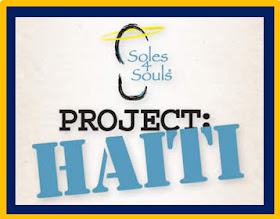
"Garmin - ✔. Water - ✔. Gatorade - ✔. Dry clothes - ✔. Coffee mug - ✔. Headband-✔. Gloves - ✔. Cell phone - ✔. Gu - ✔.
(Whoever said all you need to run is a pair of shoes was lying...)" This was posted on Facebook this morning by a running/blogging buddy of mine,
Dena just before heading out on her 20-mile run. I couldn't help but chuckle when I read it.
You do often hear
(especially by non-runners), "Well, you picked a good sport because all you need are your shoes." I guess maybe that's true if you live in a nudist camp in South Florida.
(The closest I've come to that was the Take Pride in Your Hide 5K, but that's a different story.) Anywho...if you're a runner, especially a distance runner, you're well aware that you'll need more than those shoes.
(Funny, my barefoot running buddy, Josh, will tell you, you need everything, but those shoes.) Even if you're a shorter distance runner, you're going to need some basic attire and equipment. In the summer you're going to need moisture-wicking, technical-fabric shorts and tops. In the winter you'll also need moisture-wicking clothing, but in the running tights, and long-sleeve variety. Plus you'll probably need some additional layers for warmth. Ca-ching, Ca-ching....
And summer or winter, don't forget that hat. You'll need a visor to keep the sun off your face and out of your eyes in the summer, and during the winter you'll need a hat with more head coverage to keep all your heat from escaping out your noggin. 100% UV protection shades are a must for the eyes as well as sunscreen for the ole bod (year round). Ca-ching, Ca-ching....
And don't forget those socks! They're not cheap either! Ca-ching....
If you're running less than an hour you probably won't need a lot in the way of hydration or energy supplements (depending on the temp). But if you're going those longer distances, you'll need to add the expense of a sports drink and probably some sports gels. And for those longer runs you'll probably want one of those hydration belts to carry all those goodies. Ca-ching, Ca-ching....
If you're a gadget hound or someone who likes to keep track of all your training statistics, you've probably doled out a few hundred dollars for a GPS such as a Garmin or Nike's version. Oh and then there are heart-rate monitors that are just as popular. Ca-ching, Ca-ching.... And what about those rainy days? Are you one of the thousands who spent thousands on a treadmill last year? Ca-ching, Ca-ching...
Do you race? I remember the days of $10 and $15 registration fees for 10Ks! (Okay, so I'm old.) Today expect to pay $25, $30, $40+ and for a half or whole marathon expect to pay $60-$100+ then add in the travel and lodging expenses, if the races are any distance from where you live. Ca-ching, Ca-ching....
Now back to those darn shoes....even if you rebel and insist on wearing your short gym shorts from the 70s with the white piping, your cotton tube socks with the color bands at the top that go all the way to your knees
(thinking that will count as a sunscreen), and a stretchy terry-cloth headband to keep the sweat out of your eyes, you're still going to end up shelling out quite a chunk of change for those shoes
(well, unless you're my friend Barefoot Josh).Okay, so running isn't the cheapest sport. That's okay. We love it anyway. Heck, most of us are addicted to checking out the latest shoes or testing out the latest nutrition, energy, and hydration products on the market. Chances are that you make a monthly if not weekly visit to the local sporting goods or running shop to check out all the new gear (don't worry, I won't tell). And we look forward to the next race for which we're training even though we might have to take out a home equity loan to pay for the registration, air fare, hotel, and food for the trip.
So, they next time someone says, "Well at least with running all you need is a good pair of shoes." just pat them on the shoulder and say, "Bless your heart."
 Welcome to the new weekly feature on RunnerDude's Blog—RunnerDude's Runner of the Week. From all over the US and the world, everyday runners just like you and me will be featured on the blog. Here's a big welcome to our first featured runner, Otto!
Welcome to the new weekly feature on RunnerDude's Blog—RunnerDude's Runner of the Week. From all over the US and the world, everyday runners just like you and me will be featured on the blog. Here's a big welcome to our first featured runner, Otto! hs after, my ex-girlfriend and I came back together one more time, and because her father was a marathon runner, we picked running as a common activity to share. That's how I got into my first 5K, and later, the 10K I was training for when I injured my back. I got hooked into running after finishing these 2 races.
hs after, my ex-girlfriend and I came back together one more time, and because her father was a marathon runner, we picked running as a common activity to share. That's how I got into my first 5K, and later, the 10K I was training for when I injured my back. I got hooked into running after finishing these 2 races.


























